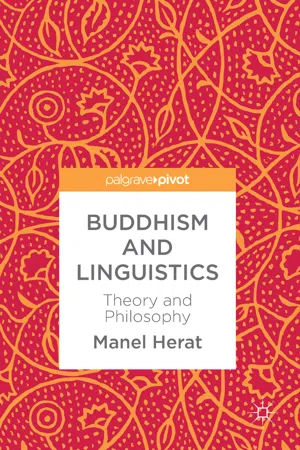The Problem of Ineffability
The narrative sequence of the Buddha’s enlightenment in the seminal work of the Buddhist yogatantras, the Sarvatathāgatatattvasaṁgraha (henceforth STTS), begins with the following question posited by the Tathāgatas to the Bodhisattva Sarvārthasiddhi , the name by which the text refers to Buddha Śākyamuni on the eve of his enlightenment:
Oh son of the lineage, how can you fully awaken
To the unsurpassed perfect complete awakening,
You who engage in austerities without having perceived
The ultimate reality of all of the tathāgatas?
The passage raises a pivotal question in the tantric Buddhist formulation of the problem of ineffability —how can one expect to attain the state of a Buddha without knowing the ultimate reality that a Buddha perceives? The question’s implications speak to the revelatory nature of Buddhist yogatantra works such as the STTS , a text that tells a new narrative of the Buddha’s awakening in which the Tathāgatas appear and reveal the nature of ultimate reality to Sarvārthasiddhi by conveying upon him a series of mantras, visualizations, and instructions. It is a yogic narrative that affirms that enlightened beings and meditators can and do interact on the epistemic level, seeing, hearing, and perceiving one another. It also tells the reader that the ultimate reality (tattva) of all of the Tathāgatas can indeed be expressed both self-referentially and confirmed pragmatically between parties in dialogue. This text’s reworking of one of the core components of Buddhist traditions, the narrative of the Buddha’s enlightenment has been argued to signal the emergence of a self-consciously tantric Buddhism in South Asia. 2 The narrative also signals, as the textual genre yoga-tantra might imply, a move toward a yogic epistemology that is specifically concerned with resolving the problem of ineffability. .
The same account of Sarvārthasiddhi’s enlightenment appears in chapter fifteen of Indrabhūti’s Jñānasiddhiḥ, one of seven works in a corpus referred to in Tibetan Buddhist traditions as The Seven Siddhi Texts (Grub pa sde bdun). Here, the narrative from the STTS is just one of several sources Indrabhūti uses to argue his thesis of a fully effable yogic realization of gnosis that is grouned in an epistemology of pervasion. The Seven Siddhi Texts are identified in the Kagyü (Bka’ brgyud) tradition of Tibetan Buddhism as some of the oldest Indic sources for the meditative traditions of ‘the great seal’ or mahāmudrā. They share this status with two other corpora, Advayavajra/Maitrīpa’s Twenty-five Amanasikāra Works (Yid la mi byed pa nyi shu rtsa lnga) and The Sixfold Corpus on the Essence (Snying po skor drug). Together, these three corpora are considered one of the oldest canons of so-called Indian Mahāmudrā Works (Phyag rgya chen po’i rgya gzhung). 3
This study of ineffability in the Indian Mahāmudrā Works focuses on The Seven Siddhi Texts. It begins by challenging a common dictum in the field of Buddhist Studies that the tantric literature of the Buddhist siddhas necessarily rejected, ignored, categorically dismissed, or were somehow hostile to the roughly contemporary discourse of Buddhist logicians and epistemologists. It argues that issues such as whether ultimate reality can be an object of perception and whether or not it can be accurately communicated are as important to these tantric authors as they are to the Buddhist epistemologist. The paper then turns to the issue of the basic epistemology that appears to be common throughout The Seven Siddhi Texts , a form of representationalism that transcends the epistemically bounded state of ordinary beings. 4 It then presents three examples of yogic epistemologies at work in The Seven Siddhi Texts that argue for an epistemically unbounded mental representationalism in their description of the ultimate reality that is attained and perceived by yogins and enlightened beings, the persistent rhetoric of ineffability in these works must be qualified. Here, it becomes evident that gnosis (jñāna), ultimate reality (tattva), and the innate (sahaja) are “ineffable” with respect to the epistemically bounded state of ordinary beings, not with respect to the unbounded state of yogins and enlightened beings.
Tantric Epistemology and “Epistemological Posturing”
An enduring bias in the field of Buddhist Studies assuming a strong dialectic between institutional and anti-institutional Buddhisms in medieval India has led some scholars to exaggerate the opposition between Buddhist tantric and epistemological literature. Because the siddha authors of some of the earliest tantric commentarial works are assumed to be anti-scholastic and thus not concerned with the epistemological literature of their contemporaries, little has been written on the epistemological material that appears in their writing. There is certainly some truth to the argument that the literature of the pramāṇikas or epistemologists and the literature of the Buddhist siddhas represent widely divergent modes of discourse, but the idea that siddha literature exhibits a total rejection of issues of epistemological concern takes the anti-institutionalism and anti-scholasticism argument too far. The literature of the siddhas reveals a parallel, extra-institutional Buddhist scholasticism primarily concerned with the practice of yoga and its integration with the ritual technology of consecration. Though not developed to the same degree of sophistication as in the literature of the Buddhist pramāṇikas, logic and epistemology certainly play a part in this project.
The two groups, the Buddhist siddhas and pramāṇikas , represent parallel early medieval Indian Buddhist scholastic movements. This scholastic parallelism likely helped to facilitate the eventual movement of tantric traditions to the center of institutional Buddhist life. The discourses on yoga from the Buddhist siddhas could later be integrated into more institutional forms of Buddhist scholasticism because they were extra-institutional, not anti-institutional, and contained a number of structures and intellectual strategies that were already properly scholastic in their own right. The tension between the revelatory discourse of the Buddhist tantras and their persistent employment of the language of ineffability required an epistemological response from the authors of The Seven Siddhi Texts , and that response drew elements from post-Dignāga Buddhist epistemological discourse as well as a more generalized discourse in ...
